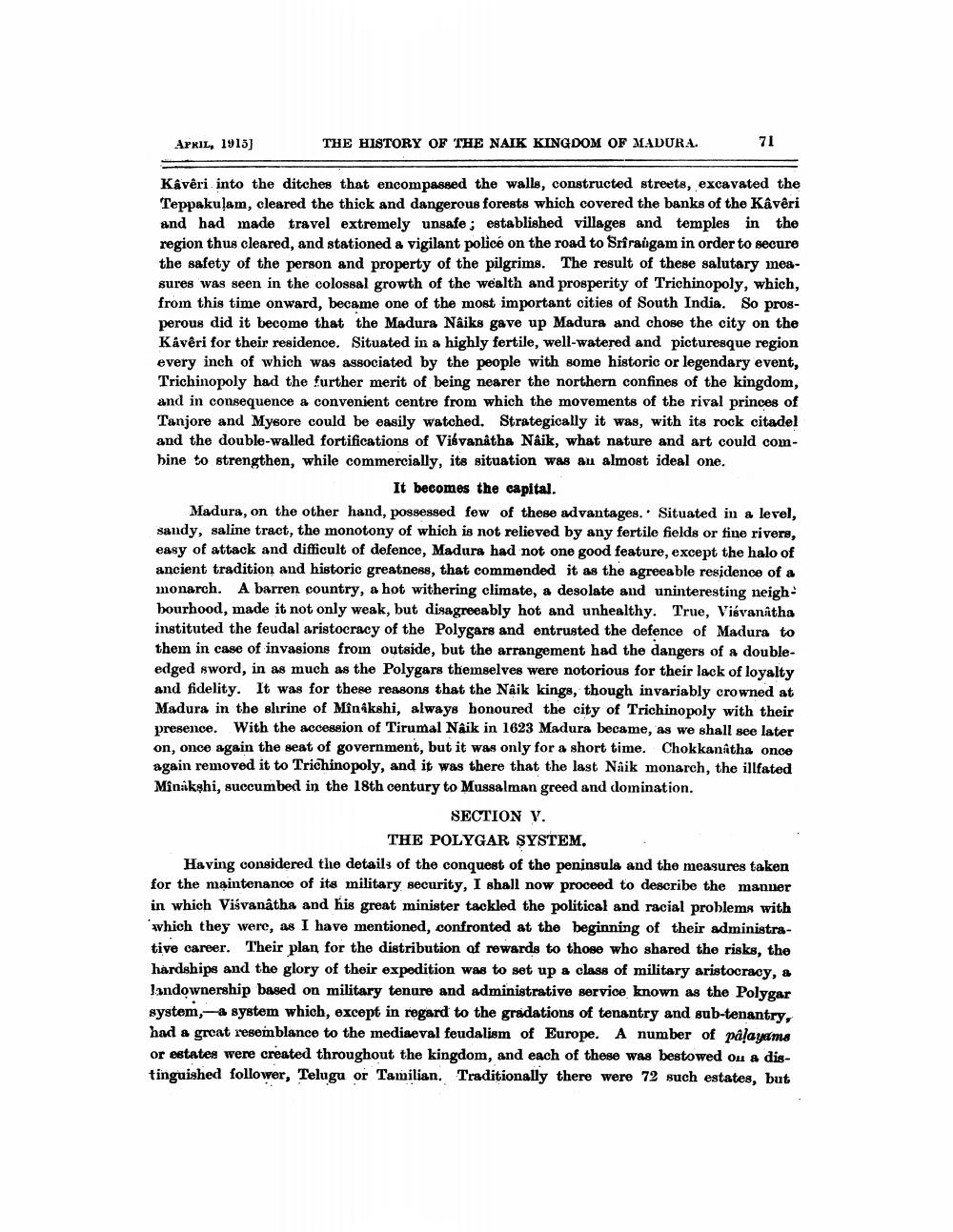________________
April, 1915)
THE HISTORY OF THE NAIK KINGDOM OF MADURA.
71
Kávêri into the ditches that encompassed the walls, constructed streets, excavated the Teppakulam, cleared the thick and dangerous forests which covered the banks of the Kâvêri and had made travel extremely unsafe ; established villages and temples in the region thus cleared, and stationed a vigilant police on the road to Srirangam in order to secure the safety of the person and property of the pilgrims. The result of these salutary measures was seen in the colossal growth of the wealth and prosperity of Trichinopoly, which, from this time onward, became one of the most important cities of South India. So prosperous did it become that the Madura Naiks gave up Madura and chose the city on the Kávéri for their residence. Situated in a highly fertile, well-watered and picturesque region every inch of which was associated by the people with some historic or legendary event, Trichinopoly had the further merit of being nearer the northern confines of the kingdom, and in consequence a convenient centre from which the movements of the rival princes of Tanjore and Mysore could be easily watched. Strategically it was, with its rock citadel and the double-walled fortifications of Visvanatha Naik, what nature and art could combine to strengthen, while commercially, its situation was an almost ideal one.
It becomes the capital. Madura, on the other hand, possessed few of these advantages.. Situated in a level, sandy, saline tract, the monotony of which is not relieved by any fertile fields or fine rivers, easy of attack and difficult of defence, Madura had not one good feature, except the halo of ancient tradition and historic greatness, that commended it as the agreeable residence of a monarch. A barren country, a hot withering climate, a desolate and uninteresting neighbourhood, made it not only weak, but disagreeably hot and unhealthy. True, Visvanatha instituted the feudal aristocracy of the Polygars and entrusted the defence of Madura to them in case of invasions from outside, but the arrangement had the dangers of a doubleedged sword, in as much as the Polygars themselves were notorious for their lack of loyalty and fidelity. It was for these reasons that the Naik kings, though invariably crowned at Madura in the shrine of Minikshi, always honoured the city of Trichinopoly with their presence. With the accession of Tirumal Naik in 1623 Madura became, as we shall see later on, once again the seat of government, but it was only for a short time. Chokkanitha once again removed it to Trichinopoly, and it was there that the last Naik monarch, the illfated Minakshi, succumbed in the 18th century to Mussalman greed and domination.
SECTION V.
THE POLYGAR SYSTEM. Having considered the details of the conquest of the peninsula and the measures taken for the maintenance of its military security, I shall now proceed to describe the manner in which Visvanatha and his great minister tackled the political and racial problems with which they were, as I have mentioned, confronted at the beginning of their administrative career. Their plan for the distribution of rewards to those who shared the risks, the hardships and the glory of their expedition was to set up a class of military aristocracy, a Jandownership based on military tenure and administrative service known as the Polygar system,-a system which, except in regard to the gradations of tenantry and sub-tenantry, had a great resemblance to the mediaeval feudalism of Europe. A number of palayams or estates were created throughout the kingdom, and each of these was bestowed ou a distinguished follower, Telugu or Tamilian. Traditionally there were 72 such estates, but




